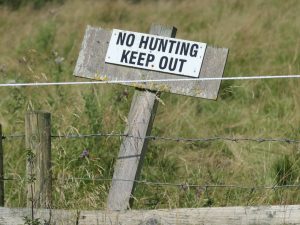The Braunstone Walk part 2: A multiplicity of notices and a rough and rowdy past.
Pictures by Jonathan Bridgland; Commentary by Ivan Idea
 It does seem to me, coming across these wild and wondrous places that we visit on our walks that there are some rather interesting people out there, including those who put up notices and then tilt them to one side, so that if one is looking at the world skewiff as it were, one can see it forthwith and straightforth.
It does seem to me, coming across these wild and wondrous places that we visit on our walks that there are some rather interesting people out there, including those who put up notices and then tilt them to one side, so that if one is looking at the world skewiff as it were, one can see it forthwith and straightforth.
For here, if you look closely, you will see string and wire of the barbed variety and then the notice atilt, as if struck by a passing minor earthquake. 
And indeed that vision was increased anon but another notice that carefully entwined the use of capital letters in the mode of a person shouting along with a lower-case letter “g” appearing from time to time.
Typographically it gives a deep insight into the state of the person writing the note, although I am sure it was written with the best of intention.
We walked towards, and they came forth to greet us and jolly conversations followed. “Moo,” said they and “moo” responded I, and we seemed to get on awfully well. But then with some regret I bade my merry chums (for some I had  come to think of them) a fond farewell and once more ventured forth.
come to think of them) a fond farewell and once more ventured forth.
And then, just when I was thinking of looking at my telephonic device to see how far we had walked, there, on the far horizon was indeed the church that was the main feature of part one of my epic journey.
And actually, on a more serious note, I would say that this picture really does capture what that village is about, nestling in the hollows away from the howling gales that I always associate with the 12th century.
I was indeed moved – and although that was mostly by the walker behind me not realising I had stopped for what us literary types like to call a “moment of emotional inspiration.” But it was nevertheless a moving moment.
We did indeed thereafter take a peek within the church, and even if no one else  did I felt the contemporary note about the concern for the organist’s well-being touching.
did I felt the contemporary note about the concern for the organist’s well-being touching.
Indeed it was a fine organ for a small village church, and I do hope it is played each Sunday, and those attending appreciate both the sums that must have been raised in the past and the dedication of a musician in keeping the tradition going.
For although the village is listed in the Domesday Book it would be wrong to think all had been peace and quite here. Allow me to quote from the Leicestershire churches website, as a way of concluding:
“By the 13th century the Neville’s held the manor passing ownership to his son before he was hanged for theft in 1276. After his death the ‘justices of the Forest’ took the manor but Theobald de Neville successfully regained it and in 1305…”
You can read the rest for yourself if you are interested. But beware: They were indeed a pretty wild bunch in medieval days and those of a more retiring nature may find the tales of clerical fisticuffs somewhat disturbing.